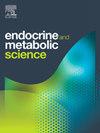青少年肥胖与ESR升高的关系:哪个更重要?
Q3 Medicine
引用次数: 0
摘要
肥胖已经成为一种全球性的流行病。一些研究表明,脂肪组织不仅是一种惰性能量储存,而且是一种与中枢神经系统沟通的内分泌器官。目的评估红细胞沉降率(ESR)与体重指数(BMI)、年龄、糖尿病和脂肪肝等并发症的存在以及体重减轻之间的关系。方法50例患者到AL-Kindy专科内分泌科门诊进行肥胖评估。随访3个月,采用学生t检验和卡方检验分析患者基线特征;P值<;0.005被认为是显著的。结果10 ~ 14岁患者ESR最高,平均ESR为56.4 mm/h, 15 ~ 19岁次之,平均ESR为51.7 mm/h。男性患者的平均ESR明显高于女性患者(53.09 mm/h vs. 25.71 mm/h)。大约80%的脂肪肝患者有高ESR。在三个月的时间里,这些患者都要接受卡路里限制饮食;研究结束时,平均BMI为31.25±1.21 kg/m2,平均ESR为20.32±30.2 mm/h,而基线ESR为35.8±42.5 mm/h。结论BMI越高,ESR水平越高。ESR值在10-14岁年龄组中最高(平均56.4 mm/h),表明全身性炎症可能先于或加速青春期肥胖的发展。本文章由计算机程序翻译,如有差异,请以英文原文为准。
The association of adolescent obesity with elevation of ESR: Which comes first?
Background
Obesity has become a global epidemic. Several studies suggest that adipose tissue is not only an inert energy store but also an endocrine organ that communicates with the central nervous system.
Objective
To assess the association between erythrocyte sedimentation rate (ESR) and body mass index (BMI), age, presence of complications such as diabetes and fatty liver disease, and weight loss.
Methods
Fifty patients visited AL-Kindy specialized endocrinology outpatient clinic for obesity assessment. Patients were followed up for three months, and their baseline characteristics were analyzed using Student's t-test and chi-square test; p values <0.005 were considered significant.
Results
The highest ESR values were observed in the age group of 10–14 years (mean ESR: 56.4 mm/h), followed by the 15–19 year group (mean ESR: 51.7 mm/h). The mean ESR in male patients was significantly higher than that in female patients (53.09 mm/h vs. 25.71 mm/h). Approximately 80 % of the patients with fatty liver disease had a high ESR. The patients were prescribed a calorie-restricted diet for three months; the mean BMI at the end of the study was 31.25 ± 1.21 kg/m2, and the mean ESR was 20.32 ± 30.2 mm/h compared with the baseline ESR of 35.8 ± 42.5 mm/h.
Conclusion
The study findings indicate that a higher BMI is associated with higher ESR levels. The highest ESR values were observed in the age group of 10–14 years (mean 56.4 mm/h), suggesting that systemic inflammation may precede or accelerate the development of obesity during adolescence.
求助全文
通过发布文献求助,成功后即可免费获取论文全文。
去求助
来源期刊

Endocrine and Metabolic Science
Medicine-Endocrinology, Diabetes and Metabolism
CiteScore
2.80
自引率
0.00%
发文量
4
审稿时长
84 days
 求助内容:
求助内容: 应助结果提醒方式:
应助结果提醒方式:


